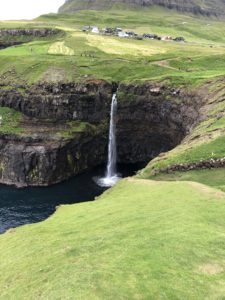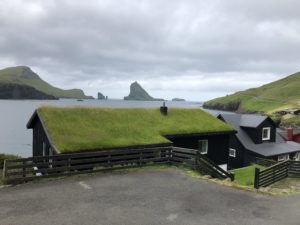
The Faroe Islands are located halfway between Norway and Iceland in the Norwegian Sea.
The islands were first discovered, according the locals, in the early 6th century by an Irish monk known as Brendan the Navigator.
Brendan set out on a voyage to discover the Garden of Eden, and instead he discovered the Faroe Islands.
Brendan is not fictional character. He is one of the most significant early Irish Christians. His discovery of the Faroes was not without consequence; he got the islands off to a good start.
After the original Irish settlement died out, the Faroe Islands were settled by the Vikings—the pagan version. Then, when our hero, Olaf Tryggvason, became a Christian, he summoned a local leader, Sigmundur Brestisson (961-1005 A.D.), from the Faroe Islands back to Norway. Olaf preached the gospel to Sigmundur and he became Christian. Olaf then sent Sigmundur back to the Faroe Islands as a missionary.
Sigmundur’s evangelistic methods were crude in keeping with the Viking way but ultimately successful, although not necessarily to be commended. One has to appreciate the aggressiveness of the Vikings in spreading the gospel but not their methods. It is one of the greats ironies of the Great Commission that one must be bold enough to share the gospel but gentle enough to be willing to die before harming another in the effort. It’s a combination only found in proper balance by the infilling of the Holy Spirit.
The Reformation arrived in 1538 and was successful. Today, 90% the islands’ 50,000 inhabitants claim to be Christian.
The Faroe Islands remind me of the other islands we have visited in this part of the world. They have beautiful landscapes and breathtaking views but few if any trees or farmable land, along with a cold, wet climate. As beautiful as the islands are no one would mistake them for the Garden of Eden.

Our excursion today consisted of a bus tour of the island and a trip to the island of Vágar, one of the Faroes, where we saw a beautiful waterfall and visited a few villages and a church.
When we returned I grabbed my iPad a found a place in the lounge on the first deck, where I intended to drink my cappuccino and read a book about Brendan the Navigator. As it turned out I sat there for nearly an hour and never turned the page. Instead, I listened to the conversation next to me between two men who had served in Jimmy Carter’s Administration in the U.S. government in 1970’s. One of them had served in the Whitehouse and had met with President Carter many times. One of the things he said about President Carter (a devout Christian) is that he always asked in policy meetings, “What is the right thing to do?”
I thought about those meetings with arguably the most powerful man in the world at the time and then thought back to Olaf Tryggvason meeting with Sigmundur Brestisson in Norway. These meetings happened half a world and a millennium apart but the kingdom of God influenced both.
One of the blessings of every Kingdom citizen to know he or she is part of something much larger than their own life or even their generation. This is true of Olaf Tryggvason, Jimmy Carter, and each citizen of the kingdom of God. We play but a small part in a very long play, but what a glorious play. GS
